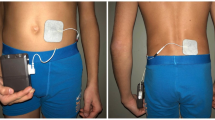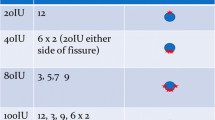Abstract
Purpose of review
To overview the current medical literature on the efficacy of botulism toxin treatment (BTX-A) for lower gastrointestinal disorders (GIT).
Recent findings
BTX-A was found to have a short-term efficacy for the treatment of dyssynergic defecation. Surgical treatment was found to be more effective than BTX-A for the healing of chronic anal fissures, and BTX-A can be considered when surgery is undesirable. Data regarding the effects of BTX-A injection for the treatment of chronic anal pain is limited. Beneficial effects were observed only in a minority of patients. BTX-A treatment was found to be effective for the treatment of obstructive symptoms after surgery for Hirsprung’s disease as well as for the treatment of internal anal sphincter achalasia.
Summary
BTX-A treatment has a short-term efficacy and is safe. Further research is still needed in order to establish the exact place of BTX-A treatment of lower GIT disorders.
Similar content being viewed by others
References and Recommended Reading
Papers of particular interest, published recently, have been highlighted as: •• Of major importance
Albanese A, Brisinda G, Mathias CJ. The autonomic nervous system and gastrointestinal disorders. In: Appenzeller O, Vinken PJ, Bruyn GW, editors. Handbook of clinical neurology, vol. 75. Amsterdam: Amsterdam North-Holland Pub. Co; 2000. p. 613–63.
•• Emile SH, Elfeki HA, Elbanna HG, et al. Efficacy and safety of botulinum toxin in treatment of anismus: a systematic review. World J Gastrointest Pharmacol Ther. 2016;7:453–62 This review provides a thorough evaluation of BTX-A in pelvic dyssynergia.
Brisinda G, Sivestrini N, Bianco G, Maria G. Treatment of gastrointestinal sphincters spasms with botulinum toxin A. Toxins. 2015;7:1882–916.
Bharucha AE. Pelvic floor: anatomy and function. Neurogastroenterol Motil. 2006;18:507–19.
Rao SS, Tuteja AK, Vellema T, et al. Dyssynergic defecation: demographics, symptoms, stool patterns, and quality of life. J Clin Gastroenterol. 2004;38:680–5.
Kuijpers HC, Bleijenberg G. The spastic pelvic floor syndrome. A cause of constipation. Dis Colon Rectum. 1985;28:669–72.
Andromanakos N, Skandalakis P, Troupis T, Filippou D. Constipation of anorectal outlet obstruction: pathophysiology, evaluation and management. J Gastroenterol Hepatol. 2006;21:638–46.
Patcharatrakul T, Rao SSC. Update on the pathophysiology and management of anorectal disorders. Gut Liver. 2018;12:375–84.
Jankovic J, Brin MF. Therapeutic uses of botulinum toxin. N Engl J Med. 1991;324:1186–94.
Hallan RI, Williams NS, Melling J, Waldron DJ, Womack NR, Morrison JF. Treatment of anismus in intractable constipation with botulinum a toxin. Lancet. 1988;2:714–7.
Joo JS, Agachan F, Wolff B, Nogueras JJ, Wexner SD. Initial north American experience with botulinum toxin type a for treatment of anismus. Dis Colon Rectum. 1996;39:1107–11.
Shafik A, El-Sibai O. Botulin toxin in the treatment of nonrelaxing puborectalis syndrome. Dig Surg. 1998;15:347–51.
Ron Y, Avni Y, Lukovetski A, Wardi J, Geva D, Birkenfeld S, et al. Botulinum toxin type-A in therapy of patients with anismus. Dis Colon Rectum. 2001;44:1821–6.
Farid M, El Monem HA, Omar W, et al. Comparative study between biofeedback retraining and botulinum neurotoxin in the treatment of anismus patients. Int J Color Dis. 2009;24:115–20.
Maria G, Cadeddu F, Brandara F, Marniga G, Brisinda G. Experience with type a botulinum toxin for treatment of outlet-type constipation. Am J Gastroenterol. 2006;101:2570–5.
Zhang Y, Wang ZN, He L, Gao G, Zhai Q, Yin ZT, et al. Botulinum toxin type-a injection to treat patients with intractable anismus unresponsive to simple biofeedback training. World J Gastroenterol. 2014;20:12602–7.
Farid M, Youssef T, Mahdy T, Omar W, Moneim HA, El_Nakeeb A, et al. Comparative study between botulinum toxin injection and partial division of puborectalis for treating anismus. Int J Color Dis. 2009;24:327–34.
Cadeddu F, Bentivoglio AR, Brandara F, et al. Outlet type constipation in Parkinson’s disease: results of botulinum toxin treatment. Aliment Pharmacol Ther. 2005;22:997–1003.
Hompes R, Harmston C, Wijffels N, Jones OM, Cunningham C, Lindsey I. Excellent response rate of anismus to botulinum toxin if rectal prolapse misdiagnosed as anismus (‘pseudoanismus’) is excluded. Color Dis. 2012;14:224–30.
Whitehead WE, Wald A, Diamant NE, et al. Functional disorders of the anus and rectum. Gut. 1999;45:1155–9.
Grimaud JC, Bouvier M, Naudy B, Guien C, Salducci J. Manometric and radiologic investigations and biofeedback treatment of chronic idiopathic anal pain. Dis Colon Rectum. 1991;34:690–5.
Jeyarajah S, Chow A, Ziprin P, et al. Proctalgia fugax, an evidence-based management pathway. Int J Color Dis. 2010;9:1037–46.
Atkin GK, Suliman A, Vaizey CJ. Patient characteristics and treatment outcome in functional anorectal pain. Dis Colon Rectum. 2011;54:870–5.
Christiansen J, Bruun E, Skjoldbye B, Hagen K. Chronic idiopathic anal pain: analysis of ultrasonography, pathology, and treatment. Dis Colon Rectum. 2001;44:661–5.
Hollingshead JR, Maeda Y, Brown TJ, et al. Long-term outcome of the use of botulinum toxin injection for functional anal pain. Color Dis. 2011;13:293–6.
•• Mapel DW, Schum M, Von Worley A. The epidemiology and treatment of anal fissures in a population-based cohort. BMC Gastroenterol. 2014;14:129 This review provides a thorough evaluation of different treatments for anal fissures and the role of BTX-A.
Lindsey I, Jones OM, Cunningham C, Mortensen NJMC. Chronic anal fissure. Br J Surg. 2004;91:270–9.
Herzig DO, Lu KC. Anal fissure. Surg Clin North Am. 2010;90:33–44.
Griffin N, Acheson AG, Tung P, Sheard C, Glazebrook C, Scholefield JH. Quality of life in patients with chronic anal fissure. Color Dis. 2004;6:39–44.
Liratzopoulos N, Efremidou EI, Papageorgiou MS, Kouklakis G, Moschos J, Manolas KJ, et al. Lateral subcutaneous internal sphincterotomy in the treatment of chronic anal fissure: our experience. J Gastrointestin Liver Dis. 2006;15(2):143–7.
Garg P, Garg M, Menon GR. Long-term continence disturbance after lateral internal sphincterotomy for chronic anal fissure: a systematic review and meta-analysis. Color Dis. 2013;15:104–17.
Chen HL, Woo XB, Wang HS, Lin YJ, Luo HX, Chen YH, et al. Botulinum toxin injection versus lateral internal sphincterotomy for chronic anal fissure: a meta-analysis of randomized control trials. Tech Coloproctol. 2014;18:693–8.
Altomare DF, Rinaldi M, Milito G, Arcana F, et al. Glyceryl trinitrate for chronic anal fissure—healing or headache? Results of a multicenter, randomized, placebo-controlled double blind trial. Dis Colon Rectum. 2000;43:174–9.
Antripoli C, Perrotti P, Rubino M, Martino A, et al. Nifedipine for local use in conservative treatment of anal fissures: preliminary results of a multicenter study. Dis Colon Rectum. 1999;42:1011–5.
Bielecki K, Kolodziejczak M. A prospective randomized trial of diltiazem and glyceryltrinitrate ointment in the treatment of chronic anal fissure. Color Dis. 2003;5:256–7.
Jensen SL. Treatment of first episodes of acute anal fissure: a prospective randomised study of lignocaine ointment versus hydrocortisone ointment or warm sitz baths plus bran. Br Med J. 1986;292:1167–70.
Eshghi F. The efficacy of L-arginine gel for treatment of chronic anal fissure compared to surgical sphincterotomy. J Med Sci. 2007;7:481–4.
Gaj F, Trecca A, Crispino P. Efficacy of anal dilators in the treatment of acute anal fissure. A controlled clinical trial. Chir Ital. 2006;58:761–5.
Gupta P. Randomized, controlled study comparing sitzbath and no-sitz-bath treatments in patients with acute anal fissures. ANZ J Surg. 2006;76:718–21.
Jensen SL. Maintenance therapy with unprocessed bran in the prevention of acute anal fissure recurrence. J R Soc Med. 1987;80:296–8.
Maria G, Brisinda G, Bentivoglio AR, Cassetta E, Gui D, Albanese A. Influence of botulinum toxin site of injections on healing rate in patients with chronic anal fissure. Am J Surg. 2000;179:46–50.
Brisinda G, Maria G, Sganga G, Bentivoglio AR, Albanese A, Castagneto M. Effectiveness of higher doses of botulinum toxin to induce healing in patients with chronic anal fissures. Surgery. 2002;131:179–84.
Nelson RL, Thomas K, Morgan J, et al. Non surgical therapy for anal fissure. Cochrane Database Syst Rev. 2012;15(2):CD00343.
Sahebally SM, Meshkat B, Walsh SR, Beddy D. Botulinum toxin injection vs topical nitrates for chronic anal fissure: an updated systematic review and meta-analysis of randomized controlled trials. Color Dis. 2018;20:6–15.
Arroyo A, Perez F, Serrano P, et al. Surgical versus chemical (botulinum toxin) sphincterotomy for chronic anal fissure: long-term results of a prospective randomized clinical and manometric study. Am J Surg. 2005;189:429–34.
Minguez M, Herreros B, Espi A, et al. Long-term follow-up (42 months) of chronic anal fissure after healing with botulinum toxin. Gastroenterology. 2002;123:112–7.
Mentes BB, Irkorucu O, Akin, et al. Comparison of botulinum toxin injection and lateral internal sphincterotomy for the treatment of chronic anal fissure. Dis Colon Rectum. 2003;46:232–7.
Davies J, Duffy D, Boyt N, Aghahoseini A, Alexander D, Leveson S. Botulinum toxin (botox) reduces pain after hemorrhoidectomy: results of a double-blind, randomized study. Dis Colon Rectum. 2003;46:1097–102.
Chumpitazi BP, Nurko S. Defecation disorders in children after surgery for Hirschsprung disease. J Pediatr Gastroenterol Nutr. 2011;53:75–9.
Langer JC. Persistent obstructive symptoms after surgery for Hirschsprung’s disease: development of a diagnostic and therapeutic algorithm. J Pediatr Surg. 2004;39:1458–62.
Neilson IR, Yazbeck S. Ultrashort Hirschsprung’s disease: myth or reality. J Pediatr Surg. 1990;25:1135–8.
Minkes RK, Langer JC. A prospective study of botulinum toxin for internal anal sphincter hypertonicity in children with Hirschsprung’s disease. J Pediatr Surg. 2000;35:1733–6.
Han-Geurts IJ, Hendrix VC, de Blaauw I, et al. Outcome after anal intrasphincteric botox injection in children with surgically treated Hirschsprung disease. J Pediatr Gastroenterol Nutr. 2014;59:604–7.
Friedmacher F, Puri P. Comparison of posterior internal anal sphincter myectomy and intrasphincteric botulinum toxin injection for treatment of internal anal sphincter achalasia: a meta-analysis. Pediatr Surg Int. 2012;28:765–71.
•• Church JT, Gadepalli SK, Talishinsky T, et al. Ultrasound-guided intrasphincteric botulinum toxin injection relieves obstructive defecation due to Hirschsprung’s disease and internal anal sphincter achalasia. J Pediatr Surg. 2017;52:74–8 This study examines the efficacy of a targeted BTX-A treatment in Hirschsprung’s disease and internal anal sphincter achalasia.
Author information
Authors and Affiliations
Corresponding author
Ethics declarations
Conflict of Interest
Dan Carter reports personal fees from Takeda, Abbvie, and Janssen, outside the submitted work. Ram Dickman declares that he has no conflict of interest.
Human and Animal Rights and Informed Consent
This article does not contain any studies with human or animal subjects performed by any of the authors.
Additional information
This article is part of the Topical Collection on Motility
Rights and permissions
About this article
Cite this article
Carter, D., Dickman, R. The Role of Botox in Colorectal Disorders. Curr Treat Options Gastro 16, 541–547 (2018). https://doi.org/10.1007/s11938-018-0205-z
Published:
Issue Date:
DOI: https://doi.org/10.1007/s11938-018-0205-z




